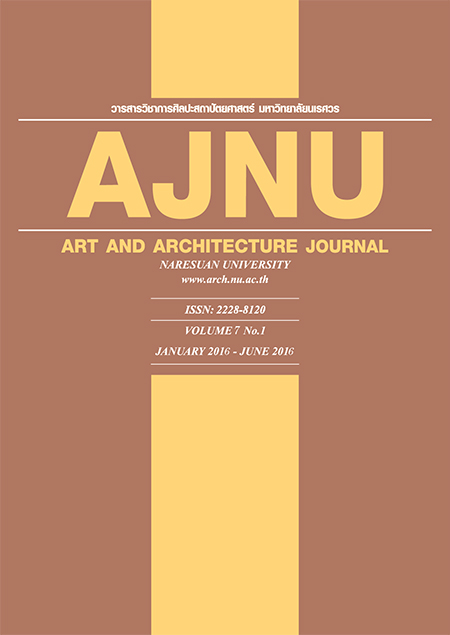การสร้างสรรค์งานทัศนศิลป์กวีทรรศน์;ชุดภพ - ภูมิของนามรูป
Main Article Content
Abstract
ปัจจุบันนี้กระแสการสร้างสรรค์ศิลปะร่วมสมัยทั้งของไทยและนานาชาติ ล้วนแล้วมีกระบวนการสร้างสรรค์ที่
หลากหลายรูปแบบหรือรูปธรรมแตกต่างกัน ดังเห็นได้จากประเภทผลงานทัศนศิลป์ ได้แก่จิตรกรรม ภาพพิมพ์ ประติมากรรม
และศิลปะสื่อประสม เป็นอาทิ ต่างก็มีกระบวนสร้างสรรค์ที่ปรากฏถึงการเปลี่ยนแปลงออกไปจากขนบนิยมเดิมๆ ที่สืบเนื่องกัน
มาอย่างมากมาย นับว่าเป็นการพัฒนาแสดงให้เห็นก้าวหน้าออกไปในแทบทุกมิติ ได้แก่ มิติทางรูปแบบ ทางเนื้อหา และทาง
กลวิธี ตลอดจนเครื่องมือสำหรับการสื่อสารการสร้างสรรค์ศิลปะนั้นๆ แต่อย่างไรก็ตามคุณค่าทางศิลปะ หรือคุณค่าทางความงาม
ที่เรียกว่า“คุณค่าทางสุนทรียภาพ”ในองค์ประกอบของศิลปะก็ยังคงเป็นแก่นสารที่สำคัญที่สุดสำหรับกระบวนการสร้างสรรค์และ
แสดงให้เห็นถึงระดับผลสัมฤทธิ์ของศิลปะอยู่เสมอ ทั้งนี้สามารถพิจารณาได้อย่างดีที่สุดจากจุดมุ่งหมายอันเป็นเจตนาในการ
สร้างสรรค์ศิลปะที่ศิลปินกำหนดขึ้น โดยทั่วไปแล้วในการสร้างสรรค์ศิลปะ สามารถจำแนกแบ่งได้ออกเป็น 3 ประเภทด้วยกัน
ดังนี้ประเภทที่ 1“ศิลปะเป็นภาษาแห่งความงาม”เป็นศิลปะที่มีจุดมุ่งหมายในการสร้างสรรค์ผลงานที่นำเสนอความงามหรือ
สุนทรียภาพทางรูปทรงเป็นสำคัญ(Formalism),ประเภทที่ 2“ศิลปะเป็นภาษาแห่งอารมณ์ ความรู้สึก”เป็นศิลปะที่มีจุดมุ่งหมาย
ในการสร้างสรรค์ผลงานที่เป็นการแสดงออกของ“เป็นภาษาแห่งอารมณ์ ความรู้สึก”สะเทือนใจเป็นคุณค่าสำคัญสุด
(Expressivism) และประเภทที่ 3“ศิลปะเป็นภาษาแห่งความคิด หรือภาษาแห่งความหมาย”เป็นศิลปะที่มีจุดมุ่งหมายในการ
สร้างสรรค์เพื่อให้ผลงานศิลปะเป็นเครื่องมือในการสื่อสาร ที่เป็นเรื่องราว เกี่ยวกับชีวิต สังคม และโลก เพื่อยกระดับจิตใจ และ
สังคมให้สูงส่งดีขึ้น โดยเน้นคุณค่าสำคัญอยู่ที่ความคิด(Instrumentalism) ในการวิจัยแบบสร้างสรรค์ (Creative Research
Project)การสร้างสรรค์งานทัศนศิลป์กวีทรรศน์;ชุด ภพ-ภูมิของนามรูป(The creation of Visual Arts Poetry; Bhava-Bhumi
of Namarupa)ดังกล่าวนี้ผู้วิจัยแบบสร้างสรรค์ ได้กำหนดจุดมุ่งหมายการสร้างสรรค์ศิลปะอันเป็นเจตนาที่สำคัญอยู่ 2 ประการ
โดยบูรณาการผสมผสานประยุกต์เข้าด้วยกันได้แก่ แนวทางการสร้างสรรค์ศิลปะเพื่อสื่อสารว่า “ศิลปะเป็นภาษาแห่งความงาม”
กับ “ศิลปะเป็นภาษาแห่งความคิด หรือภาษาแห่งความหมาย” ในการสร้างสรรค์งานทัศนศิลป์กวีทรรศน์ (The creation of
Visual Arts Poetry)ชุดนี้ ได้กำหนดให้มีรูปแบบหรือส่วนที่เป็นรูปธรรม (Form):ที่แสดงกระบวนการทดลองสร้างสรรค์
นวัตกรรมทางศิลปะรูปแบบใหม่ขึ้นด้วยการนำศิลปะจากสองประเภท ที่มีทั้งคุณลักษณะคล้ายกัน และแตกต่างกัน ตลอดจนมี
ความสัมพันธ์กันพอสมควรมาบูรณาการประยุกต์แทรกเข้าด้วยกันให้เกิดเอกภาพที่เหมาะสมและลงตัวมากที่สุด อย่างแรกก็คือ
วิจิตรศิลป์ (Fine Art )ประเภททัศนศิลป์ (Visual Arts) ได้แก่ จิตรกรรม (Painting) วาดเส้น (Drawing) และอย่างหลังคือวิจิตร
ศิลป์(Fine Art )ประเภทกวีนิพนธ์ (Poetry) ได้แก่ ประเภทโคลง กลอนสุภาพ แม้ว่าทั้งสองล้วนมีรูปธรรม ที่ต้องมองเห็นรับรู้ดู
ได้ด้วยตาเป็นสำคัญเหมือนกันก็ตาม แต่ทว่าในทางกลับกันแล้ว ต่างก็มีสุนทรียธาตุหรือสุนทรียภาษาที่สื่อให้รับรู้ดูเห็นถึง รูปแบบ
ความหมาย และความเข้าใจ รวมทั้ง ความรู้สึก ที่ผิดแผกกัน เพราะว่าประเภททัศนศิลป์ (Visual Arts)นั้น ใช้ภาษาทัศนธาตุ
ได้แก่ จุด เส้น สี แสง เงาและที่ว่าง สื่อแสดงถึงคุณค่าทางสุนทรียภาพทางศิลปะส่วนประเภทกวีนิพนธ์ (Poetry) ใช้ภาษาแห่ง
ถ้อยคำ สำนวนโวหาร การแปลความหมาย ความเข้าใจในสัญลักษณ์(ผ่านตัวอักษร)ต่างๆ ที่ผูกเชื่อมโยงเข้าด้วยกันเป็นประโยค
อธิบายข้อความต่างๆ เพื่อสื่อแสดงถึงคุณค่าทางสุนทรียภาพทางศิลปะหรือ“รส”แห่งกวีนิพนธ์ตามหลักอลังการศาสตร์ ในการ
สร้างสรรค์งานทัศนศิลป์กวีทรรศน์(The creation of Visual Arts Poetry)ชุดนี้ นอกจากเป็นกระบวนการสร้างสรรค์ที่แสดงให้
เห็นถึงการบูรณาเข้าด้วยกันระหว่าง ทัศนศิลป์ (Visual Arts) กับกวีนิพนธ์ (Poetry) อย่างมีเอกภาพแล้ว ยังเป็นเครื่องประจักษ์
ชัดว่า“ศิลปะเป็นภาษาแห่งความคิด หรือภาษาแห่งความหมาย” กับ“ศิลปะเป็นภาษาแห่งความงาม”สามารถนำมาการบูรณา
การผสมผสานกัน เพื่อใช้เป็นเครื่องมือหรือพาหะแห่งความคิดที่บัญญัติขึ้น(Concept)เป็นสำคัญ จนกลายเป็นการพัฒนาและ
เชื่อมโยงต่อยอดเกิดความก้าวหน้าการสร้างสรรค์ศิลปะ ให้แปลกใหม่อย่างมีคุณค่าทางสุนทรียภาพและมีอัตลักษณ์ที่พิเศษ
เฉพาะตัวออกไป สำหรับส่วนนามธรรมหรือเนื้อหา (content):ผู้วิจัยสร้างสรรค์ให้ความสำคัญพิเศษ ต่อความหมายและหัวข้อ
ธรรมะในพระพุทธศาสนา ตามหลักของ “พุทธธรรม”สอนให้มองเห็นสิ่งทั้งหลายอยู่ในรูปของส่วนประกอบต่างๆ ที่มาประชุมกัน
เข้า โดยตัวตนแท้ๆของสิ่งทั้งหลายนั้นหามีไม่ เมื่อแยกส่วนต่างๆ ที่มาประกอบกันเข้านั้นออกไปหมดก็จะไม่พบตัวตนของสิ่งนั้น
เหลืออยู่เลย แต่ทว่าให้ความสำคัญพิเศษต่อความเกี่ยวข้องเรื่องชีวิต โดยเฉพาะในด้านจิตใจหรือธาตุรู้การแสดงส่วนประกอบ
ต่างๆ จึงต้องครอบคลุม ทั้งวัตถุและจิตใจ หรือทั้งรูปธรรมและนามธรรมเป็นการแบ่งอย่างกว้างๆ ว่า“นามและรูป” หรือ
นามธรรม กับรูปธรรม ได้แก่ นามคือ จิต เจตสิก กับรูป คือ รูปธรรม หรือรูปขันธ์ แต่กระนั้นก็ดีส่วนนามนั้น ยังแบ่งได้แยกย่อย
อีกคือ จิตะวิญญาณขันธ์ เจตสิก เวทนาขันธ์ สัญญาขันธ์ และสังขารขันธ์ เป็นต้น นอกจากเรื่อง“นามรูป”แล้ว ผู้วิจัยสร้างสรรค์มี
ความสนใจศึกษาเป็นพิเศษเกี่ยวกับ “ภพ-ภูมิ” ที่มีปรากฏในพุทธธรรมอย่างสำคัญยิ่ง ได้แก่“ภพ”หมายถึงโลกเป็นที่อยู่ของสัตว์
ภาวะชีวิตของสัตว์มี 3 คือ: กามภพ รูปภพ และอรูปภพ(เทียบเท่าคติภูมิ) หรือเรียกว่า ไตรภูมิ หมายถึงโลกียภูมิทั้งสามนั่นเอง
ดังนั้นสัมฤทธิผลของการสร้างสรรค์งานทัศนศิลป์กวีทรรศน์(The creation of Visual Arts Poetry) ชุดนี้ มีจำนวนผลงานวาด
เส้นดินสอดำ ดินสอสี ปากกาเคมี ผสมผสานงานจิตรกรรมกลวิธี สีอะครายลิค สีน้ำมัน สีพาสเทลชนิดน้ำมัน ทั้งหมด 8-10 ภาพ
ทั้งหมดนี้บรรลุวัตถุประสงค์ทั้งในส่วนรูปแบบ (Form)และเนื้อหา (Content) ตลอดจนกลวิธี (Technique) เป็นเครื่องยืนยันถึง
นวัตกรรมการสร้างสรรค์ศิลปะ ที่สำแดงอัตลักษณ์ เฉพาะตนได้อย่างเป็นรูปธรรมปรากฏขึ้นมาอย่างชัดเจน ในการนี้สามารถ
วิเคราะห์สรุปผลสำเร็จ และขั้นตอนการปฏิบัติงานสร้างสรรค์ได้ดังนี้ โดยมีการแต่งบทร้อยกรองเป็นกวีนิพนธ์ขึ้นก่อนแล้วจึง
ค่อยๆพัฒนารูปแบบ เนื้อหา ของกลอนนั้นให้ลงตัวเป็นบทกวีนิพนธ์ตามลำดับต่อไป ทั้งนี้ก็อาศัยการสร้างสรรค์ผลงานวาดเส้น
ผสมผสานงานจิตรกรรม ให้เกิดเป็นภาพแบบร่าง (Sketch) และพัฒนาขึ้นเป็นผลงานขยายจริงขึ้นตามลำดับ มีคุณค่ารูปแบบ
ภาพสัญลักษณ์ เนื้อหาเรื่องราว ให้สอดคล้องคล้อยตาม และเชื่อมโยง เข้ากับความคิดเป็นความบันดาลใจในการแต่งบทกวี
นิพนธ์ จนสามารถนำมาสร้างสรรค์ศิลปะ แบบบูรณาการร่วมกันขึ้นใหม่ โดยการเขียนบทกวีนิพนธ์นั้นเป็นลักษณะตัวอักษร
วิจิตร หรือตัวอาลักษณ์อันเป็นรูปแบบเฉพาะตัว ผสานกลมกลืนกันอย่างเป็นเอกภาพ
Nowadays, the contemporary art created movement of the world has various styles for instance; painting,
printed making, sculpture, mixed media, and etc. Each genre has developed its making process from the
previous day which effects the change in almost every aspect such as form, content, procedure, and
medium. However, the aesthetic value of the art is strongly concerned with art composition; the outcome
of the completed piece is always revealed the level of achievement which determined the purpose of
creator. Generally, art production can be categorized into three types. Firstly; formalism, art is the language
of beauty. The purpose of this type emphasizes on compositional elements of making process. Secondly,
expressivism-an artistic style of critical emotion and feeling such as depression; an artist wants to depict
about subjective emotions which arouse inside. Finally, art is a language of thoughtfulness or meaning. The
purpose of this genre is for being a communication tool which presents a story of way of life, society, and
the world. In addition, the artist intends to elevate mind and society by focusing on the core values of the
idea. This type is called instrumentalism.
For this creative research project - visual art poetry creation in the series of Bhava-Bhumi of Namrupa
has two objectives which are intercommunicated art integration and adaptation of art as a language of
beauty and interpretation. In the creative procedure, form is acted as an innovation of a new art style by
combining both two related art genres which have similarly and differentially characteristics. The new
established type reveals perfect proportion and unity. Although the concrete form of both visual art using
painting and drawing and poetry using Thai octameter poem-Klonsupap have to be view by vision, they
have different aesthetic element because of their diverse elements; visual art elements are point, line,
colour, tone, shade, shadow, and space while poetry language element are word, phraseology,
interpretation, and understanding letter symbolism. The poetry elements are put together into a sentence
in order to present aesthetic value of art or taste of poetry by relied on literature rules. Despite the unity of
the art work, it also indicated that art is the language of thoughtfulness or denotation and the language of
beauty that can be integrated to create new art genre with aesthetic values and an identity. In part of
content, the meaning and Buddhism morality are the main topic of creation because Dharma teaches to
see thing in term of components with compounded parts. The mere existence of the thing is nothing so
that mind is focused as the most important part of life. The various components symbols are denoted both
material and mind, on the other hand concrete and abstract are called name and form for example name
as a mental and matter as a concrete or Skandhas. The substitutes of name are Chita-mind, Vinnana
Skandhas-consciousness, Vedana Skandhas-sensation, Sanna Skandhas-perception, Sankhara Skandhasmental
formation, and so on. In addition, this creative research has particular studied about “Bhava-Bhumi”
in Buddhist morality with included Bhava (the continuity of life and death) -place where organism is living.
The living organism condition has three states named Tri-Bhumi (three stages) which are Khamma Bhumi,
Rupa (form) Bhumi, and Arupa Bhumi. The result of this project is achieved perfectly as in the objective.
There are totally 8-10 paintings using pencil, color, and marker drawing; acrylic; oil; and oil pastel as
mediums. The new style of creative art innovation is successfully confirmed and revealed the unity of the
art work in a combination of form, content, along with technique. Additionally, the new unique style is
working as an obvious artist identity. In conclusion, the achievement analysis and working process can be
described as the following; first, the verse poetry is composed then gradually develops a style that fits the
content of the poem. Next, in visual art part begins with sketching the idea of form and content using
drawing and painting techniques then improve the sketch to an actual decision size painting. In the poetry
part, fine characters and singular form of scribes are mixed and become oneness. The completed paintings
of visual arts poetry; Bhava-Bhumi of Namarupa are revealed the unity of visual element of visual art that
perfectly blend with the poetry language element and content.

